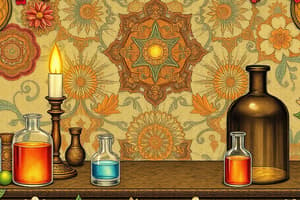Podcast
Questions and Answers
Which of the following cations forms a blue precipitate when reacted with aqueous sodium hydroxide?
Which of the following cations forms a blue precipitate when reacted with aqueous sodium hydroxide?
- Cu2+ (correct)
- Ca2+
- Fe2+
- Zn2+
Which of the following cations forms a precipitate that dissolves in excess aqueous sodium hydroxide?
Which of the following cations forms a precipitate that dissolves in excess aqueous sodium hydroxide?
- Cu2+
- Pb2+ (correct)
- Fe3+
- Ca2+
The reaction of which of the following cations with aqueous sodium hydroxide produces a green precipitate?
The reaction of which of the following cations with aqueous sodium hydroxide produces a green precipitate?
- Fe3+
- Al3+
- Fe2+ (correct)
- Zn2+
Aqueous sodium hydroxide solution is added dropwise to a solution containing an unknown cation. A white precipitate forms that dissolves when the solution is warmed. Which of the following is the most likely identity of the unknown cation?
Aqueous sodium hydroxide solution is added dropwise to a solution containing an unknown cation. A white precipitate forms that dissolves when the solution is warmed. Which of the following is the most likely identity of the unknown cation?
Which of the following cations forms a white precipitate with aqueous sodium hydroxide that remains insoluble in excess sodium hydroxide solution?
Which of the following cations forms a white precipitate with aqueous sodium hydroxide that remains insoluble in excess sodium hydroxide solution?
When an unknown cation is reacted with aqueous sodium hydroxide, a white precipitate forms and then dissolves upon the addition of excess sodium hydroxide. The precipitate also dissolves when the solution is warmed. Which of the following cations could be present?
When an unknown cation is reacted with aqueous sodium hydroxide, a white precipitate forms and then dissolves upon the addition of excess sodium hydroxide. The precipitate also dissolves when the solution is warmed. Which of the following cations could be present?
A colorless solution is warmed with aqueous sodium hydroxide. A colorless gas is released, and moist red litmus paper turns blue. What is the identity of the unknown cation?
A colorless solution is warmed with aqueous sodium hydroxide. A colorless gas is released, and moist red litmus paper turns blue. What is the identity of the unknown cation?
What is the balanced chemical equation for the reaction of iron(III) ions with aqueous sodium hydroxide to form iron(III) hydroxide?
What is the balanced chemical equation for the reaction of iron(III) ions with aqueous sodium hydroxide to form iron(III) hydroxide?
Flashcards
Qualitative Analysis
Qualitative Analysis
The process of identifying components in a substance or mixture, like cations or anions.
Cation
Cation
A positively charged ion that is attracted to the cathode in electrolysis.
Aqueous Sodium Hydroxide
Aqueous Sodium Hydroxide
A chemical solution used to test for metal cations through precipitation reactions.
Precipitate
Precipitate
Signup and view all the flashcards
Calcium Hydroxide
Calcium Hydroxide
Signup and view all the flashcards
Ammonia Test
Ammonia Test
Signup and view all the flashcards
Copper(II) Hydroxide
Copper(II) Hydroxide
Signup and view all the flashcards
Aluminium Hydroxide
Aluminium Hydroxide
Signup and view all the flashcards
Study Notes
Qualitative Analysis: Identifying Cations
- Qualitative analysis identifies components of a substance (e.g., cations and anions in an ionic compound).
- Identifying Cations using Sodium Hydroxide: Metal cations form insoluble metal hydroxides when reacting with sodium hydroxide solution.
- To identify a metal /ammonium ion, create a solution of the unknown solid in water.
- Add sodium hydroxide dropwise, note any precipitate color.
- Add excess sodium hydroxide to see if precipitate dissolves . If no precipitate forms, gently warm and test for ammonia gas.
Cation Reactions with Sodium Hydroxide
- Calcium (Ca²⁺): White precipitate, insoluble in excess sodium hydroxide.
- Aluminum (Al³⁺): White precipitate, dissolves in excess sodium hydroxide solution, forming a colorless solution which is soluble in excess sodium hydroxide.
- Lead (II) (Pb²⁺): White precipitate, dissolves in excess sodium hydroxide, forming a colorless solution, soluble in excess sodium hydroxide.
- Zinc (Zn²⁺): White precipitate, dissolves in excess sodium hydroxide, forming a colorless solution, soluble in excess sodium hydroxide.
- Copper (II) (Cu²⁺): Blue precipitate, insoluble in excess sodium hydroxide.
- Iron (II) (Fe²⁺): Green precipitate, insoluble in excess sodium hydroxide
- Iron (III) (Fe³⁺): Red-brown precipitate, insoluble in excess sodium hydroxide.
- Ammonium (NH₄⁺): No precipitate, ammonia gas is evolved when warmed causing changes in moist red litmus paper, changing it to blue.
Studying That Suits You
Use AI to generate personalized quizzes and flashcards to suit your learning preferences.




